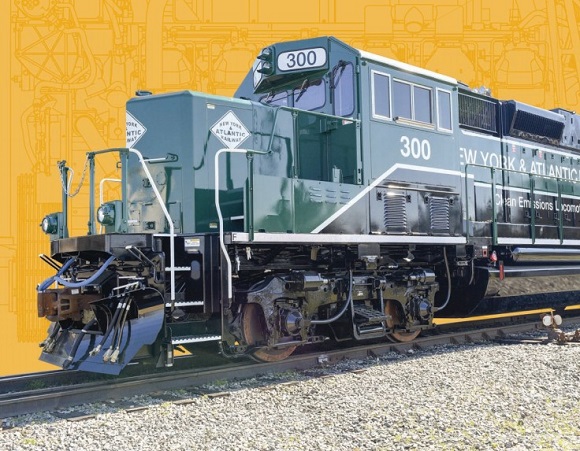Communities near freight rail operations in Community Board 5 have been advocating for cleaner air to breathe since the late Glendale Property Owners Association President “Uncle” Vito Maranzano called for cleaner locomotive technology way back in 2001. In response to concerns that 100 of my neighbors and I raised in 2004, CB5 held a special public meeting about the problem of freight locomotive pollution. The result was that NYC Parks installed a “vegetative buffer” on Otto Road next to Fresh Pond Yard in Glendale. However, the locomotive pollution continued. In 2009, I joined with the leaders of Juniper Park Civic Association and other civics to found Civics United for Railroad Environmental Solutions: “CURES.” Our number one goal has always been replacement of the ancient, high polluting Switch Duty Cycle locomotives the New York & Atlantic Railway uses with the cleanest Tier 4 Switch Duty Cycle locomotives. Public health science tells us that our families and workers need as close to zero locomotive emissions as possible for our health and quality of life.1
In 2011 and 2013, the dream of having the cleanest locomotives working in our neighborhoods started to become reality when federal, state, and city officials began funding the purchase of Tier 4 Switch Duty Cycle locomotives. DSNY, NYCEDC, and Waste Management (WM) partnered up to secure a $1 million US EPA grant award – matched by cash from WM’s own pocket. WM and Congress Member Grace Meng were instrumental in keeping this project on track. In 2018, Knoxville Locomotive Works delivered WM’s Near Zero Emissions Tier 4 Switch Duty Cycle to Fresh Pond Yard, where New York & Atlantic Railway (NY&AR) crews report it is working well. This new Tier 4 locomotive is able to pull 80 rail cars up the Mt. Olivet grade – the steepest grade in the entire LIRR rail system.
Since 2013, Assembly Member Andrew Hevesi has submitted a $3M funding request to the Speaker of the State Assembly each year. The Legislature and Governor have approved $18M to date: enough funding for at least six Tier 4 locomotives. Assembly Member Michael Miller has been working with Hevesi on this year’s request, which will bring the total to $21M. Senator Joe Addabbo and Assembly Members Catherine Nolan and Brian Barnwell also have provided support. So why in 2019 is there only one Tier 4 locomotive purchased by a private company using a federal grant working out of Fresh Pond Yard?
The same insular, wasteful culture that has fueled MTA debt while failing to deliver acceptable passenger service has derailed procurement of the cleanest freight locomotives. For example, in 2014 and 2017 LIRR sold a total of four of the old locomotives owned by LIRR to the NY&AR. LIRR sold all four for the ridiculously low price of $43,400 total, in violation of Public Authorities law and without regard for resulting public health harms. LIRR sold the old locomotives even though they were worth up to million dollars, state appropriations already were available to replace them, a procurement for Tier 4 locomotives already was underway, and there were additional grants LIRR could apply for to replace them. This LIRR locomotive giveaway also allowed the NY&AR to avoid about $7,000 in monthly lease payments to LIRR. The NY&AR’s continued use of these old locomotives keeps four locomotives – the equivalent of 120,000 cars – unnecessarily polluting our residential neighborhoods and others across Long Island, as the illustration below shows.
In 2015, it came to light that LIRR and NY&AR rigged LIRR’s 2013 locomotive procurement for a preferred vendor and tried to make it look like a competitive procurement. The result was that LIRR bought two prototype locomotives that were still in development, instead of buying proven, lower cost, lower polluting locomotives off the shelf. Senator Addabbo and Assembly Member Miller arranged a meeting at the Governor's office in March 2016 about this problem. MTA and the Governor’s office then stopped the 2013 procurement and promised to conduct an open, fair procurement for the cleanest Tier 4 locomotives.
However, LIRR’s subsequent 2018 procurement also has been tainted by illegal favoritism and restrictive specifications. To make matters worse, the procurement was crafted with a costly consulting firm: STV. A career LIRR employee who retired as LIRR's Chief Mechanical Officer and went to work for STV prepared the tainted 2018 RFP with LIRR staff. This soaked up precious state dollars that were appropriated to clean community air. This type of “revolving door” at MTA agencies – where former MTA employees go to work for “established” MTA consulting firms –has been identified recently as contributing to LIRR’s financial and service problems by the New York Times1 and Railway Age2. This “revolving door” at LIRR is part of the “Money Thrown Away” culture that advances private interests, amplifies LIRR's insularity, and suppresses the innovation, competition, and cost-efficiency the MTA Board and President Eng are demanding now.
Only a fair and open competition for the cleanest Tier 4 Switch Duty Cycle locomotives will provide MTA-LIRR with optimum product value and long-term cost-effectiveness. MTA-LIRR needs this transparency as a stepping stone toward a new culture. It needs this financially to ensure the procurement of best value and viable competitive products. It needs this open competition to acquire proven air quality technologies that passenger and freight services require on Long Island. And it needs to fulfill its commitment to provide workers, residents, and passengers the cleanest possible air to breathe.
1. “ARB Locomotive Standards Petition to U.S. EPA,” https://www.arb.ca.gov/railyard/docs/final_locomotive_petition_and_cover_letter_4_13_17.pdf
2. Brian M. Rosenthal, “Why Does Subway Construction Cost So Much? Congress Wants to Find Out,” “The Most Expensive Mile of Subway Track on Earth,” The New York Times
nytimes.com/2018/03/28/nyregion/new-york-subway-construction-costs-congress.html
nytimes.com/2017/12/28/nyregion/new-york-subway-construction-costs.html
3. David Peter Alan, “NYCT Canarsie Tunnel shutdown reversal may produce ripple effects,” Railway Age
railwayage.com/passenger/rapid-transit/nyct-canarsie-tunnel-shutdown-reversal-may-produce-ripple-effects/




